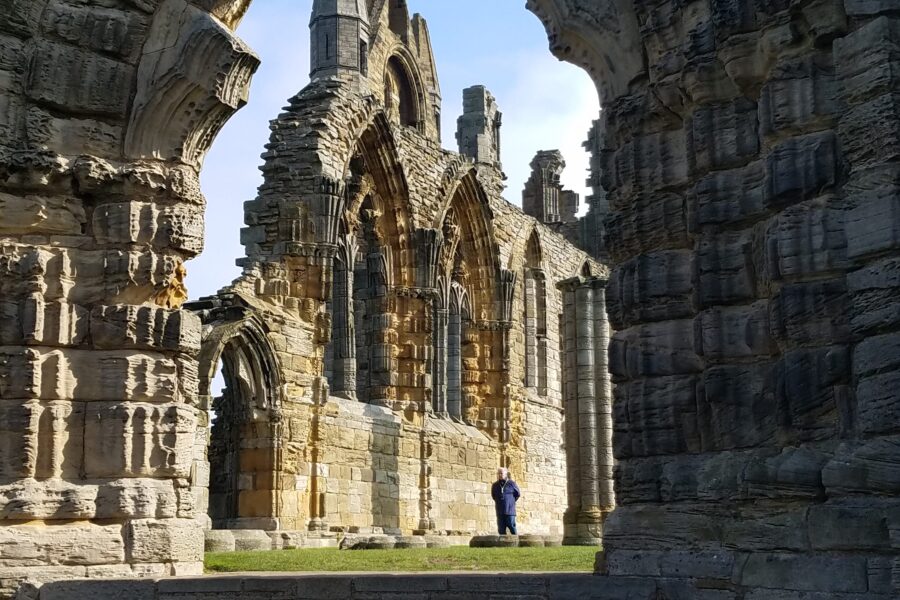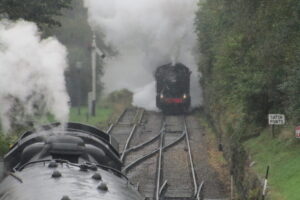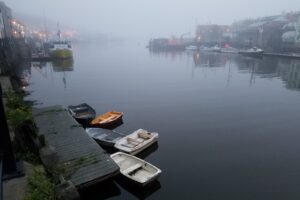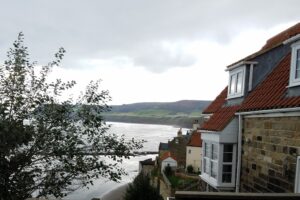Sitting here, I feel I can see everything and I know my seat is better than his. However he is probably leaning over the side taking it all in, not missing a thing. I hold my breath as I watch the bus make a narrow beyond narrow “s” turn onto a street that looks like it is for foot traffic only. The English accented narrative tells me things about Whitby I never would have discovered on my own and takes us to areas that perhaps we would not have found.
At the top of a high cliff I am confronted with what I thought was open land, but is instead populated with a half finished crescent of posh hotels built hundreds of years ago. Construction began when a local railroad magnate decided to revitalize Whitby as a tourist destination when the whaling industry was on the wane. The dream unfinished, because that same railroad magnate wasn’t quite honest.
When the bus stops for awhile, and I feel the wind won’t blast me off the top, I brave the open air and sit beside Michael. It is much cooler and windier in the area he has chosen, even when we are standing still. He tries to convince me that it really isn’t so bad. I’m not convinced. As more people get on the bus during our long pause I begin to panic, worrying I will be stuck in the cold open air forever.

Originally named Streanæshealh, the earliest record of a permanent settlement here is the year 656 when the Christian king of Northumbria founded the first abbey under an abbess, not an abbot housing both monks and nuns—separate residences of course. Two centuries later the early monastery was destroyed by Viking raiders and renamed Whitby by the Norsemen. We trundle by hotels Bram Stoker stayed in while he wrote his Gothic novel inspired by the windswept, timeworn ruins that guard the town on the cliff above our current home.
When Michael walks to the front of the bus and asks if I want to get off, I don’t have to think twice. The choice is easy, hop off now, or walk up one-hundred-and-ninety-nine steps later. I hardly ever do research on where we are going, always throwing a dart, waiting to see what is there when we alight. But Whitby Abbey and its inspiration for Bram Stoker’s Dracula hit me in the face when I searched for a place to stay after deciding to nix a quick trip to Ireland in between our stays in Wales and York; that literary tie and the apartment on the water sealed the deal.
Walking across the wide cobbled courtyard we purchase tickets to view the abbey ruins; Michael also purchases an audio tour accompaniment for each of us. We hear often that the building where we stand is tied to the abbey, but it is the end of the abbey’s story, not the beginning. Out of the visitor’s center, confronting cool and windy sunshine, the skeleton of the ancient Benedictine Abbey draws me like a magnet. Lonely. Alone. Desolate. Stalwart. Silent.

The ruins are delicate and lacy and ravaged, and the bluff on which it stands, high above the North Sea, has been trod on by Romans as well as Vikings and Normans and Anglo Saxons and kings and monks and holy men and sinners. As everything on this island, the history is long and complicated, starting in the Bronze Age and ending with me standing here today.




Alone I wander among the soaring arches and towering columns and broken stones, lost in my own thoughts and the story that unfolds on the audio tour. The ghost of the abbey that reaches for the heavens this sun-drenched, blustery, September day had its current architectural beginnings in the 13th century, and its demise in the 16th century when a king threw a tantrum. I find Michael and we walk toward a bench sheltered by a high wall, hopefully out of the wind.

As we sit I say, “Henry VIII was a bastard—as bad as the Vikings. He destroyed and pillaged and razed and threw his wives away like used Kleenex.” No historian, I am opinionated, and hearing that Henry’s coffers were empty at the time he wanted to divorce his wife during my audio tour, I continue. “I bet Henry just used Ann Boleyn as an excuse to break from the church so he could dismantle the wealth of the abbeys in England, sell the spoils, and fill his purse with gold.” It sounds plausible even if it might not be accurate. A long while later I am still pissed off at Henry VIII as we walk toward St. Mary’s Church, and it colors my mood and perspective on the world.
Compared to the delicate bones of the abbey that soar behind me, this church is squat and square—the personification of stolid. I can’t find an ounce of gracefulness anywhere. The suffocating number of square boxes that fill the interior are foreign to me. There is no room to breathe. I can barely see over these wooden stalls unless I stand on tip toe, and then I see a hierarchy of cushions and bare wood. Spacious cushioned stalls close to the front, proceedingly narrower and barer as they march to the back. I look at Michael and say, “People could come to church, curl up in their box and go to sleep without anyone knowing—till the minister mounted his pulpit.”



I avoided the one-hundred-and-ninety-nine steps from below, but now there is no quick way down to the Quay other than stepping on one and then another and another and another… I wonder what descending 199 steps does to your knees and shins and calves—nothing, I hope.

At the Whitby Abbey, Bram Stoker’s Dracula was everywhere, having never read the original, I had to purchase a copy — teeny tiny pocket sized.









Leave a Reply
Your email is safe with us.